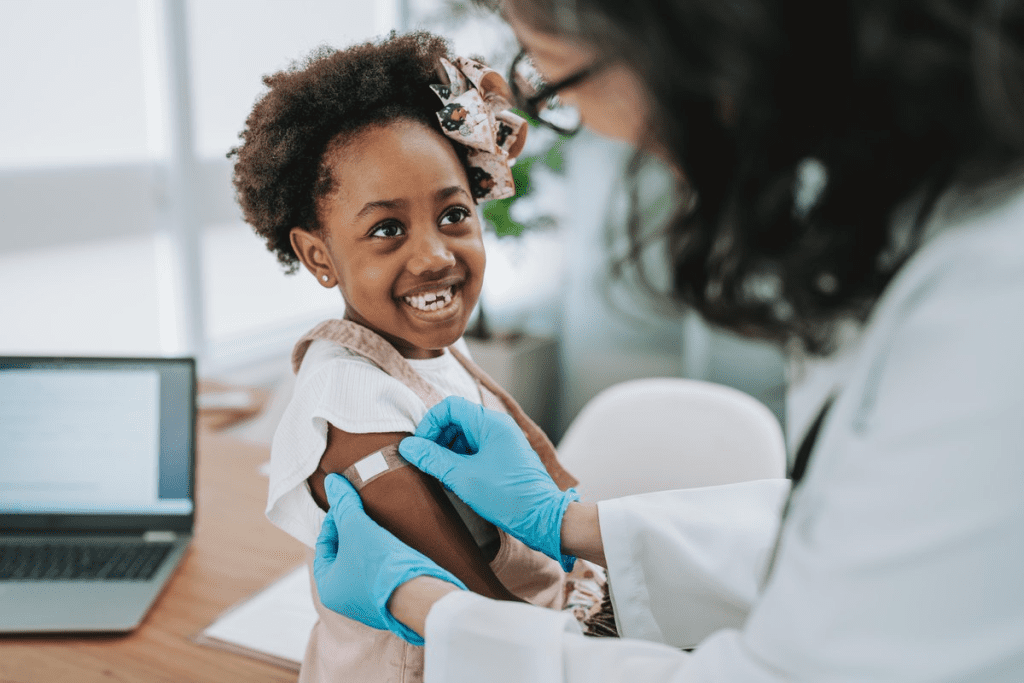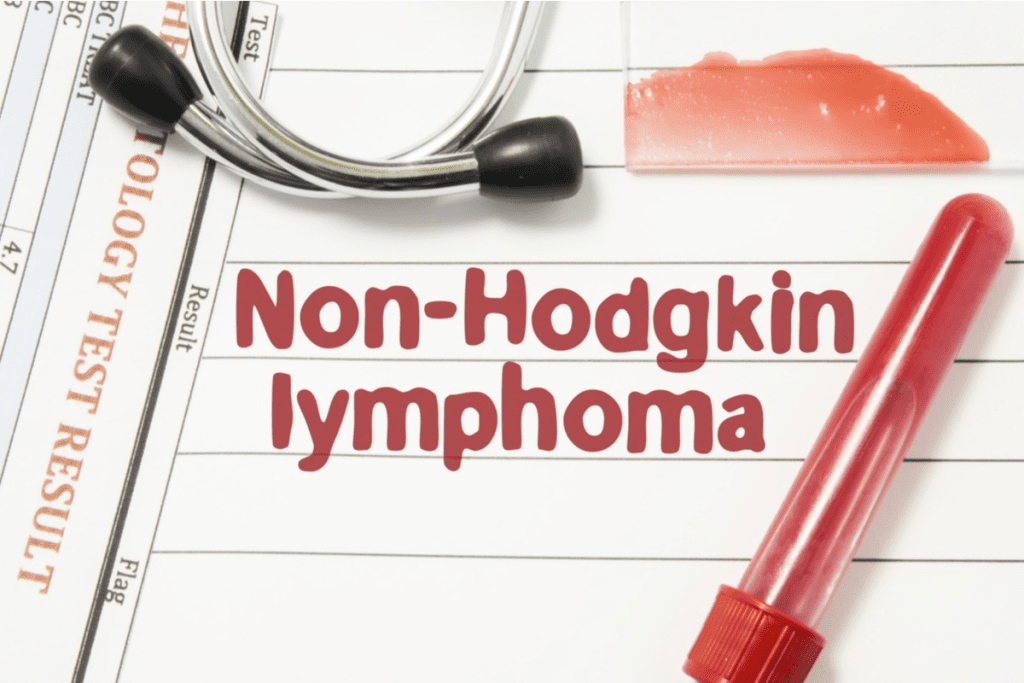Last Updated on November 14, 2025 by Saadet Demir
Lymphoma in children is a big worry, being the third most common cancer in kids. It happens when white blood cells called lymphocytes grow too much.
Children with lymphoma might show signs that look like common infections. This makes it important to spot these signs early. Common symptoms include painless swollen lymph nodes, fever, night sweats, and feeling very tired.

Knowing these signs and symptoms of childhood cancer is key to better treatment and survival. We aim to offer full support to international patients looking for top-notch medical care.
Childhood lymphoma is a serious condition that affects many young people. It’s important to know about it to catch it early and treat it well. Lymphoma is a cancer that starts in the lymphocytes, a key part of our immune system. It’s a common cancer in kids, and we’ve made big strides in treating it.

There are two main types of lymphoma in kids: Hodgkin lymphoma and non-Hodgkin lymphoma. Studies show that about half of kids with lymphoma have Hodgkin, and the other half have non-Hodgkin.
Hodgkin lymphoma has Reed-Sternberg cells, which are abnormal lymphocytes. It spreads in a certain order from one lymph node group to the next. Non-Hodgkin lymphoma, on the other hand, is a mix of cancers without Reed-Sternberg cells. It can start in any lymphoid tissue and grows faster than Hodgkin lymphoma.
Knowing the difference between these two types is key to finding the right treatment. Both can cause lymph node swelling, but their treatments and outcomes are different.
Some main differences between Hodgkin and non-Hodgkin lymphoma in kids include:
One of the main signs of lymphoma in kids is when the lymph nodes get bigger. This usually doesn’t hurt. It’s a worry for parents because it might mean something serious is going on. Knowing about swollen lymph nodes and when to get help is very important.
Swollen lymph nodes can show up in different places, like the neck, armpits, and groin. In kids with lymphoma, these nodes often pop up in the neck or just above the collarbone. Knowing where these nodes might swell can help spot problems early.
Swollen lymph nodes from infections usually hurt and go back to normal in two to three weeks. But lymph nodes that get big because of lymphoma don’t hurt and don’t go back down. Knowing these differences is key to figuring out when to worry about swollen lymph nodes in kids.
Key differences include:

Knowing these differences can help parents and caregivers spot warning signs. If swollen lymph nodes don’t go away or if other symptoms show up, it’s time to see a doctor. A healthcare professional can give a full check-up.
It’s important to know the B symptoms of lymphoma, like fever, night sweats, and weight loss. These signs can show up early in kids. They are key to spotting the disease quickly.
A persistent fever is a major B symptom in kids with lymphoma. This fever keeps coming back. It often comes with other signs and is a big clue to the disease.
Fever patterns can differ, but in lymphoma, they usually keep happening. It’s key for parents to watch their child’s temperature closely. This is even more important if other symptoms are there too.
Key characteristics of fever in lymphoma:
Night sweats are a big B symptom of lymphoma in kids. These sweats are not just a little warm. They can make clothes and bedding wet.
Night sweats in lymphoma often go with other symptoms. They show how the body is fighting the disease. It’s important to tell them apart from other reasons for night sweats, like infections or hormonal changes.
“Night sweats can be a debilitating symptom, significantly impacting a child’s quality of life. It’s essential to address these symptoms promptly to ensure proper diagnosis and treatment.”
Unexplained weight loss is a big B symptom in kids with lymphoma. This weight loss happens fast. It often comes with fever and night sweats.
It’s important to watch a child’s weight and health closely. Unexplained weight loss can mean lymphoma if it’s with other B symptoms.
Childhood lymphoma can show up in many ways, affecting a child’s health. These signs can change how a child feels and works. They can even affect organs.
Fatigue is a common symptom in kids with lymphoma. It’s not just feeling tired. It’s a deep exhaustion that makes daily life hard. A pediatric oncologist notes, “The fatigue from lymphoma can really hold kids back from doing things they love.”
This tiredness can come from the cancer itself or how the body reacts to it. It’s important for parents to watch their child’s energy. If they notice big changes, they should tell their doctor.
Kids with lymphoma might feel pain or discomfort in their belly. This is because organs like the spleen or liver get bigger. This happens when lymphoma cells build up in these organs.
These belly symptoms can be different for each child. Some might feel full or uncomfortable after eating. Others might have more pain. If these symptoms don’t go away or get worse, it’s important to see a doctor.
Lymphoma can also cause breathing problems. This includes coughing, trouble breathing, or chest pain. These issues happen when lymphoma affects the chest area. It might press on or block airways or big blood vessels.
Any breathing problems need to be seen by a doctor right away. They can be a sign of a serious issue. Parents should watch for any changes in how their child breathes or feels in their chest.
Knowing about these extra signs of childhood lymphoma is key. It helps catch the disease early and manage it better. By understanding these symptoms, parents and doctors can help kids with lymphoma get the best care.
Lymphoma in children often shows common symptoms. But there are rare and serious signs that need quick action. These unusual symptoms can be hard to spot and may need a detailed check-up.
In rare cases, lymphoma can cause neurological symptoms. This happens when the disease affects the brain or spinal cord. Symptoms include:
These symptoms can be due to lymphoma spreading to the brain or spinal cord. Or, they might be caused by pressure effects.
Lymphoma can also impact blood cells, leading to various symptoms. Some of these include:
These blood-related symptoms can greatly affect a child’s health. They need quick medical care.
In conclusion, though rare, these serious lymphoma symptoms in children are critical. They require quick medical attention for timely treatment.
Lymphoma is a common cancer in kids. Knowing how it spreads and what causes it helps doctors treat it better.
There are two main types of childhood lymphoma: Hodgkin lymphoma (HL) and non-Hodgkin lymphoma (NHL). Non-Hodgkin lymphoma is more common in children than Hodgkin lymphoma. It also grows and spreads faster.
Lymphoma in kids happens most often in those aged 1-4 for NHL and in teens for HL. Some things can make a child more likely to get lymphoma, like:
These factors can weaken the immune system or cause genetic damage, leading to lymphoma.
Studies show that non-Hodgkin lymphoma is about 2-3 times more common in boys than in girls. The exact reasons are not known, but it might be due to immune or genetic differences.
Knowing these patterns helps doctors diagnose and treat lymphoma in kids more effectively.
Spotting the signs of lymphoma, like swollen lymph nodes or fever, is key. This way, we can catch it early and treat it better.
Knowing the signs of lymphoma in kids is key to getting help early. As a parent, spotting the warning signs is vital. It helps in catching the disease early and starting treatment.
Some symptoms in kids might mean they could get lymphoma. Look out for swollen lymph nodes that don’t hurt and don’t seem to be from an infection. Also, watch for unexplained weight loss, persistent fever, and night sweats. If your child shows any of these, see a doctor right away.
Don’t ignore fatigue, abdominal pain, or respiratory issues if they keep coming back or get worse. These could mean lymphoma or another serious illness that needs quick doctor’s care.
If your child’s symptoms worry you, start by talking to a pediatrician or primary care doctor. They will check your child, ask about their health, and might do some tests like blood work or imaging.
If tests suggest lymphoma, your child will see a specialist, like a pediatric oncologist or hematologist. They will do more tests, like biopsies of lymph nodes or tissues, to confirm the diagnosis.
Knowing how doctors diagnose lymphoma can help ease worries. It’s important to do all the tests and see the doctors they recommend. This ensures a correct diagnosis and the right treatment plan.
Getting a lymphoma diagnosis for a child is tough for families. It’s key to know what comes next to help them through treatment. This ensures the best chance for a good outcome.
Many kids with lymphoma can get better and live long lives with the right treatment. Spotting signs early, like swollen lymph nodes, is vital. This helps catch the disease early.
Families need to watch for pediatric cancer signs and symptoms. If they see something off, they should get medical help fast. Knowing lymphoma signs and symptoms helps parents fight for their child’s health. They can work better with doctors to find the best treatment.
Dealing with lymphoma in children is complex. But buying informed and seeking medical help is important. With the right care, many kids can beat this disease and live healthy lives.
Symptoms include swollen lymph nodes without pain, fever, night sweats, and feeling very tired. They also might lose weight without trying. These signs can change based on the lymphoma type and where it is.
Hodgkin lymphoma has Reed-Sternberg cells. Non-Hodgkin lymphoma doesn’t. The treatment and how well they do differ between these two.
Lymph nodes from lymphoma are usually painless and don’t go away. They might also come with fever and weight loss. Infections, on the other hand, cause painful lymph nodes that often get better on their own.
B symptoms include fever, night sweats, and unexplained weight loss. They’re important because they show the disease might be more serious. This can affect how treatment is planned.
Risk factors include genetic issues, some infections, and certain chemicals. But many kids get lymphoma without any known risk factors.
Doctors use physical checks, imaging, and biopsies to diagnose lymphoma. Finding out can take several tests and talks with different doctors.
Treatment depends on the lymphoma type, stage, and the child’s health. It might include chemotherapy, radiation, or immunotherapy.
Look for persistent fever, severe tiredness, trouble breathing, and bad stomach pain. These could mean a serious lymphoma issue.
Yes, many kids with lymphoma can be cured today. It depends on the disease type, stage, and how well the child responds to treatment.
Supportive care helps with lymphoma’s physical and emotional symptoms and treatment side effects. It includes managing pain, helping with nutrition, and counseling for the mind.
Yes, treatment can lead to long-term issues like more cancer risk, infertility, and heart problems. It’s key to have ongoing care to watch for these issues.
Subscribe to our e-newsletter to stay informed about the latest innovations in the world of health and exclusive offers!